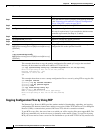
20-12
Cisco IOS Software Configuration Guide for Cisco Aironet Access Points
OL-29225-01
Chapter 20 Managing Firmware and Configurations
Working with Configuration Files
• The access point forms a password named username@apname.domain. The variable username is the
username associated with the current session, apname is the configured host name, and domain is
the domain of the access point.
The username and password must be associated with an account on the FTP server. If you are writing to
the server, the FTP server must be properly configured to accept your FTP write request.
Use the ip ftp username and ip ftp password commands to specify a username and password for all
copies. Include the username in the copy command if you want to specify only a username for that copy
operation.
If the server has a directory structure, the configuration file is written to or copied from the directory
associated with the username on the server. For example, if the configuration file resides in the home
directory of a user on the server, specify that user's name as the remote username.
For more information, refer to the documentation for your FTP server.
This section includes this information:
• Preparing to Download or Upload a Configuration File by Using FTP, page 20-12
• Downloading a Configuration File by Using FTP, page 20-12
• Uploading a Configuration File by Using FTP, page 20-13
Preparing to Download or Upload a Configuration File by Using FTP
Before you begin downloading or uploading a configuration file by using FTP, perform these tasks:
• Ensure that the access point has a route to the FTP server. The access point and the FTP server must
be in the same subnetwork if you do not have a router to route traffic between subnets. Check
connectivity to the FTP server by using the ping command.
• If you are accessing the access point through a Telnet session and you do not have a valid username,
make sure that the current FTP username is the one that you want to use for the FTP download. You
can enter the show users privileged EXEC command to view the valid username. If you do not want
to use this username, create a new FTP username by using the ip ftp username username global
configuration command during all copy operations. The new username is stored in NVRAM. If you
are accessing the access point through a Telnet session and you have a valid username, this username
is used, and you do not need to set the FTP username. Include the username in the copy command
if you want to specify a username for only that copy operation.
• When you upload a configuration file to the FTP server, it must be properly configured to accept the
write request from the user on the access point.
For more information, refer to the documentation for your FTP server.
Downloading a Configuration File by Using FTP
Beginning in privileged EXEC mode, follow these steps to download a configuration file by using FTP:
Command Purpose
Step 1
Verify that the FTP server is properly configured by referring
to the “Preparing to Download or Upload a Configuration
File by Using FTP” section on page 20-12.
Step 2
Log into the access point through a Telnet session.


















